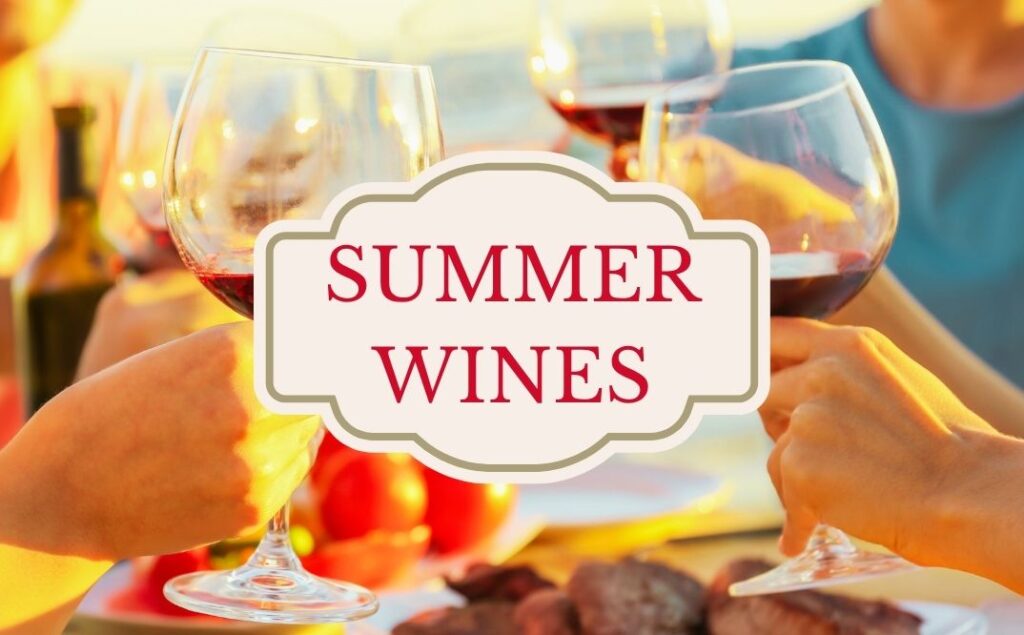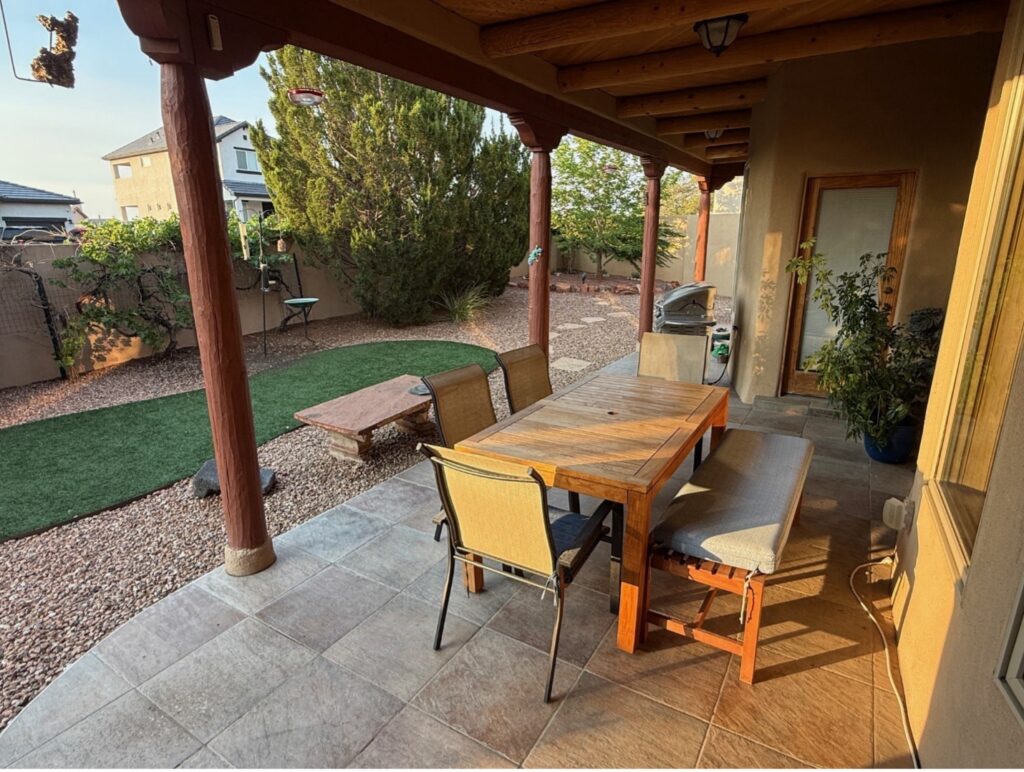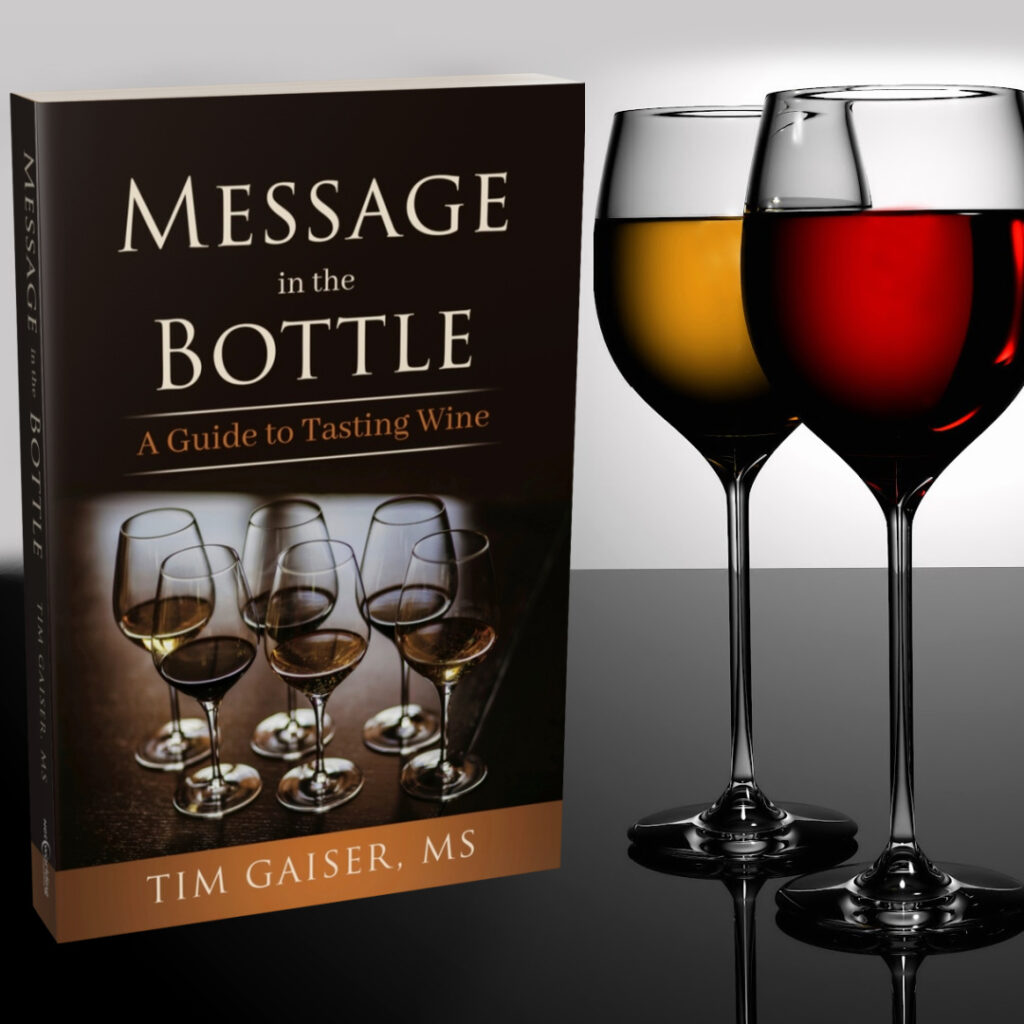
Whites, Rosés, and Reds for the Grill
We’ve been back in New Mexico for almost eight years. Before then, Carla, the kids, and I lived for 30-plus years in San Francisco. There, the months of June through August were the antithesis of summer. While the rest of the country sweltered in seasonal heat, we had flannel sheets on the beds. And if I was grilling something in the back yard, I wore a fleece.
Things are different now in the land of high and dry. High as in over 5,400 feet in elevation and dry as in a desert climate. But four seasons are definitely in order here with summers hot as expected. It was 102 yesterday. However, unlike Phoenix and Las Vegas, where it’s like living inside a solar flare, there’s a diurnal shift here of at least 30-degrees year-round because of the elevation. Last night the temps got into the 60s after being a scorcher during the day.

Now to the lead into the above photo and then talking about summer wines … I took the image on my phone at 6:30 the other morning. Several things about it. First, note the vigas (wooden beams) over the patio, as our house was designed in a New Mexican style. Second, the lack of grass. Like most yards here, ours are zero-scaped, as in rocks. That’s because water rates in Rio Rancho, where we live, are among the highest in the state. The green patch you see is artificial turf that Bennie, Carla’s late Dad, added soon after the house was built to give the yard a splash of color. Maybe he also used it to practice putting. Otherwise, the most important thing about the photo for our purposes is the table with chairs and a bench, and the grill beyond. A word about the latter.
The grill is hooked up to the gas line in the house. So there’s no mucking about with propane tanks or lighting charcoal. However, if you turn all four burners on, it gets to 600 degrees within minutes. Meaning once you put something on the grill, you can’t ignore it—even for 30 seconds. Any protein will incinerate lickety-split if you’re not watching it, requiring carbon dating after the fact. But with practice, the grill can do anything to perfection in short order, provided you also use a meat thermometer.
Curiously enough, we don’t dine out on the back patio as much as you’d think. While it was always too cold to dine outside in the rarely sunny Sunset District in the City, the opposite is true now. Even though the back of the house faces east and is out of direct sunlight after 4:00 PM, it’s often too hot to eat outside. My rule is that it has to get below 90 or it’s uncomfortable. Then there’s the bugs. Most, like flies and mosquitoes, are almost tolerable. The latter only appear after it rains, and after the temp dips below a certain point. Wasps, however, are a different story. They’re incredibly aggressive getting at your food. And they won’t think twice about going after you if you come between them and dinner. In fact, there have been times in the past when we’ve abandoned dinner on the Lido Deck, as we call the back patio, and headed inside because of the wasps.However, this year I have a secret weapon in the form of one of those bug zappers shaped like a small tennis racket. I have yet to use it, but I will let you know how it works out.
Now to the matter at hand. A blog post/article about summer wines is one of those seasonal things that appears every year in magazines (the few that are left), papers, and online posts like this one. If you’re a freelancer, you get asked to write an article about summer wines usually sometime in February or March, depending on the lead time of the client. So while you’re still bundled up inside with the heat on, you’re asked to write about sipping rosé by the pool. Talk about a transmogrificational experience. Whatever the case, any sage advice about so-called summer wines can be broken down into a few basic guidelines. Here they are along with some recommendations that we’ve enjoyed at the Casita de Peña y Gaiser in the last few years.
Summer Wine Recommendations
I. Unoaked, high-acid white wines are versatile and work well with a wide range of dishes.
Examples: Riesling, Sauvignon Blanc, Albariño, Grüner Veltliner, and Italian whites including Pinot Grigio, Pinot Bianco, Soave, and Pigato
Recommendations:
2023 Craggy Range Sauvignon Blanc, Marlborough: We drink a lot of Sauvignon Blanc during the summer months—and year-round, for that matter. Craggy Range is one of my go-to’s. It’s elegant, seamless, and restrained when it comes to the pyrazines department.
2023 Inama Soave Classico, Veneto: There’s a lot of Soave on the market but few of them are as good as Inama. One of my favorites.
Dönnhoff Weissburgunder: It’s a rare occurrence when Pinot Blanc overachieves. But this is Dönnhoff—one of the top wineries in Germany. Delicious—seek it out.
2022 Punta Crena Pigato, Liguria: Pigato is a relative of Vermentino and shows it with a rich texture, saline minerality, and vibrant acidity.
II. Dry rosés are the most versatile summer wines. They work well with lighter dishes but can easily cross over to be enjoyed with grilled protein.
Examples: Rosés from Tavel, Bandol, Provence, Rioja, Sancerre, and Austrian Zweigelt
Recommendations:
2024 Bieler et Fils Coteau d’Aix en Provence: Quintessential Provence rosé without the high price tag. Bieler et Fils also uses screwcap. I wish more rosé producers did.
2023 Schloss Gobelsburg Zweigelt Rosé, Kamptal: My reason for including Zweigelt–one of Austria’s major red grapes–in my rosé list. Light in color—almost a gris de gris. Schloss Gobelsburg is one of Austria’s great wineries. Everything they do is outstanding.
2023 Txomin Etxaniz Rosado Txakoli: You may not be able to pronounce it, but Txakoli Rosadois delicious and a perfect summer pink wine.
2022 Domaine de Fontsainte Gris de Gris Rosé, Corbières: A longtime favorite summer wine (actually year-round). Based on Grenache Gris from vineyards in Corbières in the Languedoc-Roussillon. The red is delicious too and could easily be chilled and enjoyed during the summer months.
III. Lighter reds can be served chilled and work well with picnic fare or anything from the grill.
Examples: Pinot Noir, Gamay, Sangiovese, Barbera, and lighter Grenache blends and Zinfandels
Recommendations:
2022 Ridge Three Valleys Zinfandel, Sonoma County: I often seek out lower tier wines from top wineries because high quality is always there. For example, simple Côte du Rhone from a good Chateauneuf producer. The same rule holds true here. The Three Valleys is a perennial favorite from one of California’s best Zinfandel producers.
2022 Jean Foillard Beaujolais-Villages: A sip of Foillard’s Beaujolais-Villages is like summer in a glass. Definitely one to chill before pouring.
2022 Paolo Scavino Barbera d’Alba: Same rule as above with the Zinfandel. Scavino is one of my favorite Barolo producers. Their Barbera is superb.
2023 Argyle Pinot Noir, Willamette Valley: This was one of the best Pinot values I tasted during the recent MS trip to Oregon.
IV. Richer reds work well with dishes from the grill as long as they have plenty of fruit and not too much tannin.
Examples: Barossa Shiraz, Zinfandel, Mendoza Malbec, and Monastrell from Jumilla
Recommendations:
2022 Yalumba Shiraz, Barossa: Yalumba is one of my favorite Australian producers. Everything they do is quality. I’m especially fond of their Viogniers, Cabernet-Shiraz blends, and Shirazes. The Barossa Shiraz bottling nails the style with its rich spicy fruit, savory notes, and integrated tannins.
2021 Susanna Balbo Signature Malbec, Mendoza: Given the fact that the Argentines eat more beef per capita than anyone else on the planet, it’s no surprise Susanna Balbo’s Malbec is the perfect mate for grilled marinated flank steak.
2022 Juan Gil Monastrell “Silver Label,” Jumilla: Another overachiever. Made from old, dry-farmed vines planted in limestone soils. Inky color and rich, deep fruit with surprisingly soft tannins. Red wines for the grill don’t get better at the price.
At what temperature should you serve summer wines?
Temperature matters. Not outside temps, because there’s nothing to be done about that. But mind the temp of the wine you’re drinking. Odds are it will quickly warm up. So serve whites and pinks a bit colder than you normally would. Also, put a chill on the lighter reds and even the grill reds. Finally, as sacrilegious as it sounds, throwing a bit of ice into your glass isn’t out of the question if the wine gets too warm.
In closing …
Finally, context still rules the day. Drink whatever you want out of whatever you want with whatever you’re having to eat. Death metal Cabernet with fish tacos? Check. Petite Sirah by the pool from a sippy cup? Got it. Whatever the case, just remember to hydrate and use sunscreen.
Learn more professional wine tasting strategies in my book,
Message in the Bottle: A Guide to Tasting Wine

